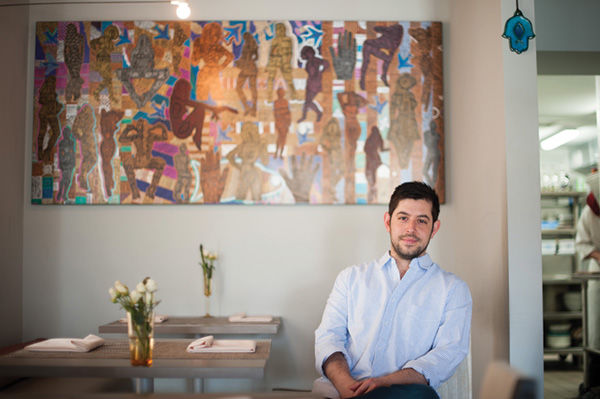A salute to the diversity of Israeli cuisine
Published July 6, 2016
Israeli food is the new darling of the culinary world.
Israeli-born chefs Yotam Ottolenghi, Alon Shaya and Michael Solomonov have become gastronomic superstars through their award-winning restaurants and cookbooks. The James Beard Foundation named Shaya’s eponymous Israeli restaurant in New Orleans the Best New Restaurant of the Year.
So what, exactly, is Israeli cuisine? I posed that question to our town’s Ben Poremba, an Israeli native who has won accolades from the James Beard Foundation, Food & Wine magazine, Bon Appetit magazine, and many of his peers in the St. Louis restaurant scene and elsewhere. He is owner of Elaia and Olio, La Patisserie Chouquette and Old Standard, all in Botanical Heights, and Parigi in Clayton.
“Israeli cuisine is the most democratic and inclusive cuisine in the world,” he said. “It is not a melting pot. It allows for different food cultures and traditions to coexist: indigenous Arab alongside Eastern European Ashkenazi; classical technique along side street food alongside hearty home cooking.”
Indeed, you can’t fully understand or appreciate the diversity of Israeli cuisine without grasping the cultural impact of the Diaspora. Israel may have been our ancestors’ homeland, but for nearly 2,000 years Jews were forced to live in communities elsewhere in the world. In the process, they created food traditions influenced by their adopted homelands. As a result, by the time Israel became the Jewish State in 1948, there was no single cuisine that could be labeled the official cuisine of the new nation.
Take, for example, the Shabbat stew. The techniques for cooking the stew are similar: combine the ingredients in a large pot, place the pot in a 100- to 125-degree oven before sundown Friday, and allow the stew to cook until noon Saturday. But that is where the similarities end.
Among the Ashkenazi, Polish Jews call their stew cholent and make it with beans, barley, potatoes and short ribs or flanken. Hungarian Jews make a version of this stew called solet, which is more likely to include kishke. French Jews make their Shabbat stew in the tradition of the iconic French stew, cassoulet. Thus, French Jews might substitute red wine as the braising liquid in place of the broth or water of their Eastern European counterparts.
But, of course, Ashkenazi Jews are not the only Jews. Among Sephardim, the Jews of Spanish and Portuguese descent prepare a Shabbat stew called adafina, a combinationof lamb, whole eggs, herbs and saffron. Iraqi Jews prepare tebit by cooking chicken, turmeric and fresh mint. Italian Jews make hamin, a mixture of collard greens, chicken meatballs and fresh sage. And in parts of North Africa, the traditional Shabbat stew, dafina, is a combination of meat, potatoes, chickpeas, dates, cumin, honey or peppery harissa and cinnamon.
And now, for the first time in two millennia, there is a Jewish nation, a tiny country made up of immigrants from more than 70 countries with most having settled there from 1948 to 1992. The result? Israel’s culinary traditions are varied and vast.
“Everyone cooks in Israel,” Poremba said. “I mean everyone.”
Poremba experienced Israeli cuisine from a great vantage point: He lived the first 17 years of his life in Israel with a mother who had culinary training in France and who worked in Israel as a chef and caterer.
“No one is afraid to play around and create and push the boundaries,” he told me. “The reference points for young aspiring chefs are enormous. We have this massive exposure to various foods and food cultures. It gives us an advanced or advantageous platform on top of which we can grow, create, explore.”
Then what are the truly native Israeli dishes? Could they be some of the foods sold by Israeli street vendors, such as falafel and hummus, sabich (a pita stuffed with fried eggplant, hard boiled eggs, chopped salad and pickles), shawarma (slow spit-roasted meats), shakshuka (spicy tomato sauce cooked with eggs), sofrito (meats sautéed with garlic, cardamom and turmeric) and barbecue kebabs?
Are those dishes uniquely Israeli? I asked Poremba.
“No,” he told me. “There are only interpretations. Nothing really originated in Israel. One example: Even the most ubiquitous dish, the chopped Israeli salad, is not ‘Israeli.’ It’s actually the Ottoman Shirazi salad. Israeli cuisine isn’t defined by dishes, but by meals and dining attitudes. That salad next to hummus next to Romanian mamaliga (polenta) next to shashuka next to goulash and stuffed cabbage. Now that’s uniquely Israeli.”
So, following Poremba’s example, you will find below the recipes for salatim – salads and dips you can serve together in classic Israeli style. Enjoy.
Margi Lenga Kahn is the mother of five and grandmother of five. A cooking instructor at the Kitchen Conservatory, she is working on a project to preserve the stories and recipes of heritage cooks. She welcomes your comments and suggestions at [email protected]















